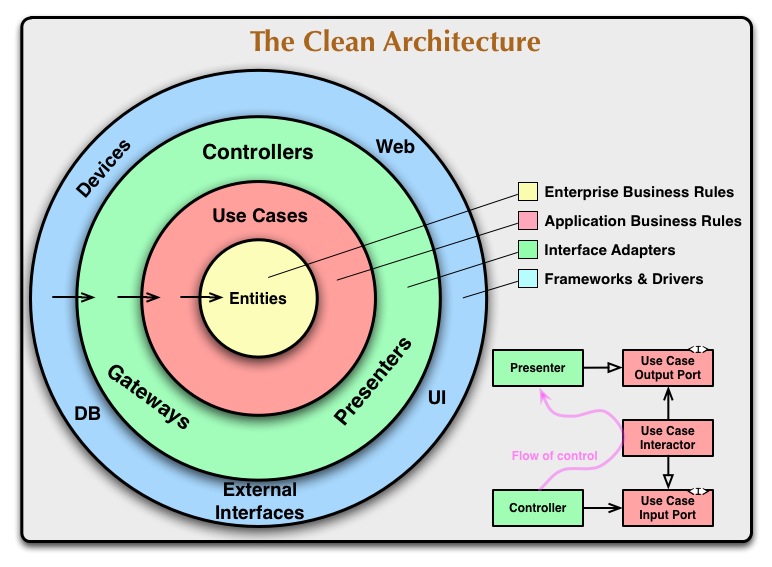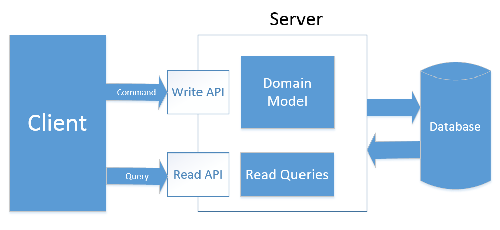Visit our website and join the mailing list. Our app is coming soon:
Clean architecture for our back-end
Today I want to continue discussing the architecture we came up with for our back-end service. In the previous article I brought up some arguments why it was important for us to separate read and write models. And the main thing that made it clear was that we operated with two different data sets for read and write operations. But I didn’t go much in to the details on how we arrived at such a different models. And this aspect of CQRS will be the topic of today’s article. Before we even realized we need to apply CQRS pattern in our design we decided to follow Uncle Bob’s Clean Architecture the same architecture we used in our mobile application development.

And the the reasoning that brought us to this architecture I lied down in one of my previous articles. Although on both platforms the overall architecture was the same but implementation details were quite different. The main attraction point of this architecture was possibility to build the server side application around the Domain Model and apply Domain Driven Development. There are several definitions for Domain Model and some of them you can find here but for us in the design process more important was to understand the peaces that constitute the Domain model. It allowed us in the next designing steps to decide whether we need a separate Domain model layer or entities were just enough. Quite often I notice that the architecture does not make a big difference between the bare bones domain entities and full domain model. In first case entities are just a database relational model, and they serve as in memory tables. In many cases especially in ASP.NET world (the framework we are using to build our back-end services) Object Relational Mappers like Entity Framework require to separate entities from the CRUD operations and thus giving impression that full-fledged Domain model is created, but in fact you end up with something what is called Anemic Domain model which is considered an anti-pattern. So following the advise of Eric J. Evans in his book Domain-Driven Design: Tackling Complexity in the Hart of Software we noted for ourselves following parts that should be presented in our Domain Model in order to consider it us a separate layer:
- Entities accompanied with business methods
- Value objects
- Repositories
- Aggregates
- Bounded Context
By analyzing our model designed for Android or iOS platform and for our back-end platform we realized that only our back-end model meets Domain Model criteria and deserves a separate layer but in case of mobile phone platforms we ended up with simple entities that were the part of application or Use Cases layer.
By modeling entities we replicate real life entity attributes, like person’s name, surname or gender that are operated by methods encapsulated in the same entity or in service. At the end of the modeling process we come up with our business model that further can be converted to the Entity-Relationship model, that is used to build the database. In such way Domain model or plain entities are tightly bound to normalized ER model. And one can live only with one ER model until the moment when displayed information starts more and more deviate from the ER model and in order to fetch the data from database more complex queries are required. And this is the time when we started to consider CQRS. But now it was not clear how to integrate the CQRS in Clean Architecture layers and we turn to the mighty Google for someone’s else experience and we found this wonderful talk that showed us exactly what we were looking for and so we ended up by extending the application layer with commands and queries and adding separate Database context or our queries.
Please visit our website and join the mailing list. Our app is coming soon:
Study: fitness boosts brainpower in adults

Physical fitness has been associated with better brain structure and brain functioning in adults.
The findings of a study, led by Dr Jonathan Repple of the University Hospital Muenster in Germany, suggests that increasing fitness levels through exercise could result in improved cognitive ability – such as memory and problem solving – as well as improved structural changes in the brain.
A group of researchers led by Repple used a publicly available database of 1,200 MRI brain scans from the Human Connectome Project and combined it with physical testing to assess the subjects’ physical fitness. Each one’s cognitive ability was also measured. The researchers excluded subjects with pre-existing conditions, such as neurodevelopmental disorders, diabetes or high blood pressure.
The results of the study showed that physical endurance was positively associated with the global cognition scores of the subjects taking part.
In its conclusion, the group of researchers said the results of the study suggest that physical exercise could be used as a form of preventative healthcare.
“The observed pattern of results appears to support the notion of a beneficial effect of physical fitness on cognitive function,” the study reads.
“This notion is supported by the few available experimental studies indicating that physical exercise leads to increases in memory performance and brain structural integrity.
“This concept might be of relevance for a wide range of domains in health and life sciences including prevention, clinical care and neurobiological research.
“Along with previous findings, our findings point to the potential of physical fitness as a modifiable factor that might be applied as an intervention in prevention and clinical care.”
The report was simultaneously published in the Scientific Reports journal and presented at the ECNP Congress in Copenhagen, Denmark.
To read the study in full, click here.
Source: http://bit.ly/30Pqjy3
Please visit our website and join the mailing list. Our app is coming soon:

Keeping Write and Read operations separately
In this article I wanted to share our team experience on how we arrived at particular architecture on our back-end solution. On the back-end we wanted to work with technologies that our team is familiar with and had an experience with before but at the same time is not outdated and has a great potential in the near future. In our case it was ASP.NET Core framework. I am not going in to the endless discussion about what framework or language is the best, from my point of view it is useless since such a topic is very biased. And I already mentioned in one of my previous blogs that despite the fact that the software development supposed to be an exact science, and many aspects of it really is, the choice of language, frameworks and best practices many times is just a matter of personal preference – something that you feel more comfortable with and it doesn’t have any scientific justification. And when I will be laying down the arguments for the solution we came up with it will be presented from our team’s point of view and how it helped us to make a design and implementation more clear and easier to understand, which might not be the case for other teams.
ASP.NET Core comes comes with some prepacked architecture that satisfied our needs. For REST full Web API solution MVC is very suitable design pattern and gave us a good starting point. Dependency injection in turn allowed us easy start to write unit tests and mock dependencies. But the more complex solution became the more we saw that we need to extend our initial project with more general architecture, after all MVC is just an UI level design pattern. This wasn’t the first project in our team’s experience when we had to split application’s code in layers. Some years ago very common was 3 tier architecture:

And we used this architecture quite a lot. In some projects we felt it suited our needs perfectly, but in some we had a feeling that we do some kind of workaround to fit the architecture. For some time I could not really even explain why those projects didn’t comply with the above architecture until the moment when I read about Command and Query Responsibility Segregation (CQRS) pattern. It was one of those aha moments when you discover what was really bothering you all this time. In the traditional 3 tier architecture the same data model and the same database is used for read and write operations. It works well when we need to display the same information we saved earlier. But the more complex application becomes the more a model we use to save data starts to deviate from a model we use to display data. For example most of the applications today require a user to create a profile or an account. Let’s say we save this information in table User and in order to do that we use an model with the same name. In case we want to see our account information we will fetch the data from the same table User. But this is only one use case where we are displaying the information about user. In real world applications information about user is displayed in many other pages together with other information, for example in e-store that would be information about product and product category, in blog that would be a post and so on. And in order to receive data suitable for a view complex queries with joins and sub-queries are used. And not only models for read and write operations are different but the requirements for those operations are different as well. In case of insert update and delete operations the database should be normalized that allows us to minimize duplicate data and avoid data modification issues. The database normalization usually results in more tables than initial design. The query operations on the other hand are focused more on performance, that can be improved by denormalizing tables. The beauty of CQRS is that it allows to separate the write and read flows by using different models and even different databases. In last case it would allow to scale the databases for read and write operations independently. And at some point of time this feature may become very crucial since write operations are significantly less that queries. As you can see there are several levels how far we can separate commands (insert, update, delete operations) from queries (read operations):
- The lowest level of read and write operation separation is on Repository level – we are using the same Domain model for write operations and for display data in UI, but we have a separate method in Repository for querying database. In order to display only necessary data we have to introduce View model and map data from Domain model to View model.
- Next level of CQRS maps View Models directly to database queries. There is no need for mapping between Domain model and View model anymore. On database level we still have normalized tables that correspond to Domain model. View models in this case correspond to queries that involves joins and sub queries.
- The two above levels of separation sometimes are not regarded as real CQRS pattern but are known as CQS (Command Query Separation) pattern, therefore only the next level of separation when write and read operations are regarded as two separate workflows throughout an application is considered as CQRS pattern.
- The final level of separation goes further even to the database layer, where each type of operations interact with its own database
In our back end API solution we decided to separate write and read operation on the application level and not to use a separate storage, but instead we are using SQL Views for queries. It allows us avoid data synchronization between the databases. But at the same time architecture is opened for further extension and possibility to add separate storage for queries. And so we ended up with following architecture:

Visit our website and join the mailing list. Our app is coming soon: